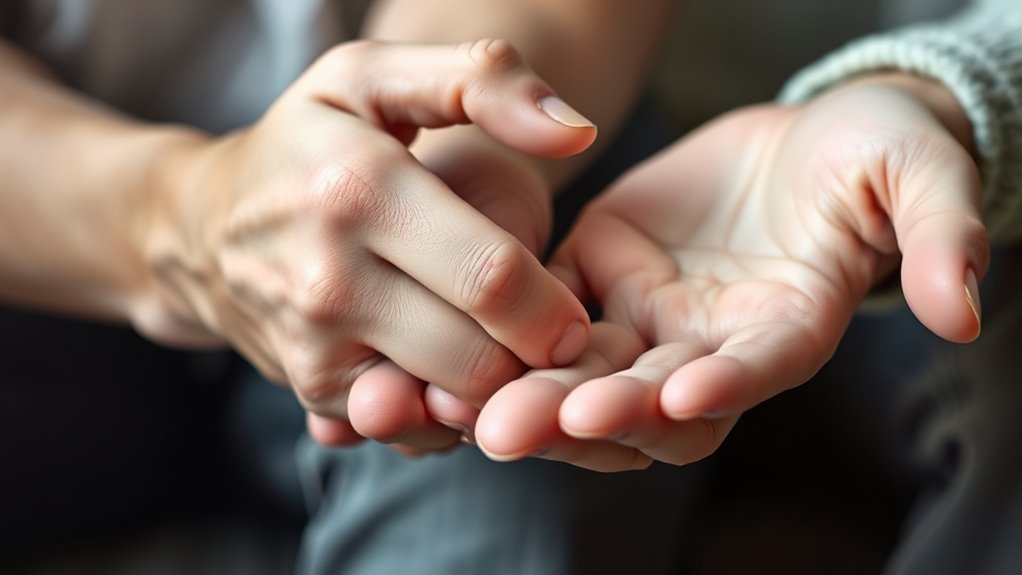Understanding attachment styles helps you see how early relationships with caregivers shape your adult connections. Your attachment style influences trust, intimacy, and emotional expression in romantic or close relationships. For example, secure attachment fosters healthy bonds, while anxious or avoidant patterns can cause difficulty with trust or closeness. Recognizing your style is the first step to improving your relationships, and exploring this topic further can help you develop healthier, more secure bonds with others.
Key Takeaways
- Attachment styles stem from early childhood experiences with caregivers, shaping trust, intimacy, and emotional regulation in adult relationships.
- Secure attachment promotes healthy communication, trust, and emotional closeness, while insecure styles can cause fear, avoidance, or dependence.
- Anxious attachment leads to clinginess and trust issues; dismissive-avoidant results in emotional distance and independence; fearful-avoidant combines both.
- Recognizing one’s attachment style helps improve relationship dynamics by addressing underlying fears and patterns.
- Developing awareness and healthy communication strategies can foster more secure, resilient adult relationships.
The Origins of Attachment Styles

The roots of attachment styles trace back to early childhood experiences with caregivers. If your early relationships involved inconsistent or unresponsive caregiving, it can lead to insecure attachment patterns. Childhood trauma, such as neglect or emotional abuse, can profoundly impact how you form bonds later in life. Attachment therapy is often used to address these early wounds, helping you process and heal from past trauma. When caregivers are unavailable or dismissive, you may develop attachment styles characterized by anxiety, avoidance, or disorganization. These early interactions shape your beliefs about trust, intimacy, and dependence. Recognizing how childhood trauma influences your attachment style is essential for understanding your adult relationship patterns and beginning the journey toward healthier connections. Additionally, understanding the early attachment patterns developed through childhood can provide valuable insight into your current relationship behaviors and emotional responses. Being aware of attachment-related behaviors can help you identify patterns that may be hindering your ability to form secure relationships. Moreover, awareness of water-related comfort levels can influence how you approach intimacy and closeness in adult relationships, especially if water metaphors like floating or emotional fluidity resonate with your attachment experiences. Developing an understanding of your own vibrational energy can further support your emotional healing and foster more secure bonds.
Secure Attachment: Foundations of Healthy Relationships

Secure attachment forms the foundation of healthy, fulfilling relationships by fostering trust, emotional openness, and resilience. When you have a secure attachment style, you’re more likely to communicate effectively and handle conflicts constructively. This openness allows you to build deeper connections and feel safe sharing your feelings. Attachment therapy can help reinforce these positive patterns if you need support developing secure traits. A strong secure attachment enhances your relationship resilience, making it easier to recover from setbacks and adapt to change. You’re more confident in your ability to trust others and seek support when needed. Recognizing the importance of emotional manipulation and understanding its effects can help you protect yourself from unhealthy dynamics. Developing an understanding of self-awareness of attachment styles can further support your relationship growth. Additionally, understanding how color accuracy impacts overall image quality can serve as a metaphor for recognizing clarity and honesty in your relationships. Being aware of how automation technology influences behavior and communication can also help you navigate modern relationship challenges. Ultimately, this attachment style promotes stability, mutual respect, and emotional well-being, creating a solid base for lasting, meaningful relationships.
Anxious-Preoccupied Attachment and Its Challenges

While a secure attachment provides a strong foundation for healthy relationships, some individuals develop an anxious-preoccupied attachment style that can present unique challenges. With attachment anxiety, you might constantly seek reassurance, feeling uncertain about your partner’s feelings. This often leads to relationship insecurity, making it hard to trust and relax. To navigate this style, consider these strategies:
- Recognize patterns of attachment anxiety and challenge negative thoughts.
- Communicate openly with your partner about your feelings.
- Practice self-soothing techniques to reduce dependency on your partner’s validation.
- Increasing your awareness of attachment styles can help you develop healthier habits and improve your emotional resilience. Becoming familiar with relationship dynamics can also provide insight into your interactions and emotional responses.
Understanding these challenges helps you build awareness and develop healthier relationship habits, despite the difficulties posed by anxious-preoccupied attachment.
Dismissive-Avoidant Attachment and Emotional Distance

Dismissive-avoidant attachment often leads you to maintain emotional distance in your relationships, preferring independence over closeness. You value your emotional independence and self-sufficiency, which can make intimacy feel overwhelming or unnecessary. This attachment style helps you avoid vulnerability, keeping others at arm’s length. You may downplay the importance of emotional connection, focusing instead on personal goals. Recognizing attachment styles can help you address underlying patterns affecting your relationships. Additionally, understanding how market trends influence your approach to emotional availability can provide valuable insights for personal growth. Being aware of exfoliation benefits might help you understand the importance of gradual emotional exposure for building trust. Managing privacy concerns is essential as it influences your comfort level with sharing personal information, which is often limited in dismissive-avoidant individuals.
Fearful-Avoidant Attachment: the Struggle With Intimacy

Fearful-avoidant attachment creates a complex struggle with intimacy because you deeply crave connection but also fear getting hurt or rejected. This pushes you to build intimacy barriers that make emotional vulnerability difficult. You might find yourself torn between wanting closeness and pulling away when it feels overwhelming. To better understand this, consider these points:
Fearful-avoidant attachment struggles with intimacy, craving closeness but fearing vulnerability and rejection.
- Fear of rejection fuels your hesitation to open up emotionally.
- Emotional vulnerability feels risky, leading to guarded behavior.
- Despite craving connection, you often sabotage intimacy to protect yourself.
- Incorporating spiritual practices like meditation and prayer can help foster inner safety and emotional resilience, making it easier to build trust.
- Recognizing grocery store hours and planning your shopping trips accordingly can reduce stress and free up emotional energy for your relationships.
- Understanding Pimple Patch technology and how it promotes healing can serve as a metaphor for the importance of self-care and patience in building trust and emotional safety.
- Being aware of filtration efficiency in your emotional life can help you identify what barriers are most effective at protecting you from pain while allowing genuine connection to occur.
These patterns create a cycle where intimacy remains elusive, making it hard to forge lasting bonds. Recognizing these challenges is the first step toward overcoming them and developing healthier ways to connect.
How Attachment Styles Influence Romantic Partnerships

Your attachment style shapes how you trust and connect with your partner, influencing the foundation of your relationship. It also guides your communication patterns, affecting how you express needs and resolve conflicts. When your emotional needs align with your partner’s, it becomes easier to build a strong, supportive bond.
Attachment and Trust Dynamics
Understanding how attachment styles shape trust in romantic relationships reveals essential insights into partner dynamics. Your attachment style influences how easily you develop trust, handle trust issues, and show vulnerability. For example, if you have an anxious attachment, you might struggle with trust issues and crave constant reassurance. Conversely, avoidant types tend to guard their vulnerability, making openness difficult.
Consider these key points:
- Secure attachment fosters healthy trust and openness, making vulnerability easier.
- Anxious attachment can lead to heightened trust issues and overdependence.
- Avoidant attachment often results in difficulty trusting and reluctance to be vulnerable.
Knowing your attachment style helps you understand your trust dynamics, guiding you toward healthier, more secure romantic connections.
Communication Patterns Shaped
Attachment styles profoundly shape how partners communicate in romantic relationships. Your attachment style influences how you set interpersonal boundaries, whether you tend to be open and assertive or avoid conflict altogether. For example, securely attached individuals tend to express their needs clearly and respect their partner’s boundaries, fostering healthy dialogue. In contrast, those with anxious or avoidant styles may struggle with conflict resolution, either becoming overly confrontational or withdrawing entirely. These patterns affect how you handle disagreements, making it harder or easier to resolve issues effectively. Over time, your attachment-driven communication style can reinforce trust or create misunderstandings. Recognizing these tendencies helps you develop more mindful communication, improving how you connect and resolve conflicts with your partner.
Emotional Needs Alignment
How do different attachment styles influence the way partners meet each other’s emotional needs? Your attachment style shapes how you seek, express, and regulate emotions in a relationship. For example, secure attachment fosters healthy emotional regulation and openness, making it easier to meet each other’s needs. In contrast, anxious attachment may cause you to cling or worry, leading to mismatched needs. Avoidant attachment might make you withdraw, leaving your partner feeling unsupported. To improve emotional needs alignment, consider attachment therapy, which helps you recognize and address these patterns. Here are three ways your attachment style impacts emotional needs:
- Determines your comfort level with vulnerability
- Influences your responsiveness to your partner’s emotional cues
- Affects your ability to provide and seek reassurance
The Role of Early Experiences in Shaping Adult Connections

Your early childhood experiences play a key role in shaping how you connect with others later in life. The bonds you form with caregivers, along with their influence patterns, set the foundation for your emotional responses. Understanding these initial experiences helps explain why you approach adult relationships the way you do.
Childhood Bonds Formation
Early experiences with caregivers play a essential role in shaping the bonds you form later in life. During childhood, your parent-child bonding and emotional development set the foundation for adult relationships. These early interactions influence your trust, intimacy, and emotional regulation.
Consider these key points:
- Secure bonds foster confidence in connecting with others.
- Consistent care during childhood promotes healthy attachment styles.
- Emotional responsiveness from caregivers shapes your ability to handle intimacy and vulnerability.
Your childhood emotional development creates a blueprint for how you approach adult relationships. Positive, nurturing experiences lead to secure attachments, while inconsistent or neglectful caregiving can result in insecure attachment styles. Understanding this process helps you recognize the roots of your relational patterns.
Parental Influence Patterns
Parental influence patterns considerably shape the way you connect with others later in life. Your early experiences with caregivers create lasting impressions that influence your adult relationships. These patterns, rooted in parental influence, form the foundation of your attachment style. Childhood memories of warmth, consistency, or neglect impact how you trust, seek closeness, or handle conflict. If your parents were supportive and reliable, you’re more likely to feel secure and confident in relationships. Conversely, inconsistent or distant parental behaviors can lead to attachment insecurities, such as anxiety or avoidance. Recognizing how parental influence shapes your perceptions helps you understand your relationship behaviors today. By exploring these childhood memories, you gain insight into your emotional patterns and can work toward healthier, more fulfilling connections in adulthood.
Early Emotional Experiences
The emotional experiences you have in childhood lay the groundwork for how you connect with others later in life. These early moments influence your ability to regulate emotions and form secure attachments. If you experienced consistent support, you likely developed healthy ways to handle emotional regulation, fostering trust in relationships. Conversely, inconsistent or neglectful experiences can hinder your attachment security.
Consider how:
- Positive early interactions promote confidence in emotional expression.
- Trauma or neglect may lead to attachment anxiety or avoidance.
- Attachment therapy can help you understand and reframe these early patterns, improving adult connections.
Your childhood emotional landscape shapes your relationship patterns, making awareness essential for building healthier bonds later on.
Recognizing Your Attachment Style and Its Patterns

Understanding your attachment style requires paying attention to your thoughts, feelings, and behaviors in close relationships. If you notice tendencies to withdraw or avoid emotional closeness, you might have attachment avoidance. This pattern often involves struggling with emotional regulation, making it difficult to manage feelings of vulnerability or intimacy. You may find yourself pulling away when things get too close or feeling uncomfortable sharing your emotions. Recognizing these patterns is essential for understanding your attachment style. Pay attention to how you respond during conflicts, how you handle intimacy, and whether you tend to suppress or dismiss your feelings. By identifying these behaviors, you gain insight into your attachment patterns, which is a vital step toward fostering healthier, more secure relationships.
Strategies for Developing Secure Attachments

Building secure attachments involves intentional actions and mindset shifts that foster trust and emotional safety. To develop this, focus on strengthening your emotional resilience and setting healthy boundaries. Here are three strategies:
- Practice self-awareness by reflecting on your feelings and reactions, helping you understand your attachment patterns.
- Communicate openly and assertively, establishing boundaries that protect your emotional safety and promote trust.
- Cultivate emotional resilience by embracing vulnerability, learning from setbacks, and remaining open to connection despite past fears.
Implementing these strategies encourages a secure attachment style, making your relationships more stable, trusting, and emotionally fulfilling. Remember, consistency and patience are key to transforming attachment patterns into healthier, more secure bonds.
Improving Relationships Through Awareness and Growth

By recognizing your attachment patterns, you can better understand your reactions and habits in relationships. Developing healthy communication helps you express your needs clearly and listen effectively. Together, these awareness and growth efforts can strengthen your connections and foster lasting intimacy.
Recognizing Attachment Patterns
Have you ever wondered why you react a certain way in your relationships? Recognizing your attachment patterns is the first step toward emotional resilience and healthier connections. By observing your reactions, you can identify patterns that reveal your attachment style. Consider these key indicators:
- How you respond to intimacy or distance
- Your comfort level with vulnerability
- Reactions to conflict or reassurance
Understanding these signs helps you recognize whether you lean toward secure, anxious, avoidant, or disorganized attachment. Attachment therapy can support you in this process, encouraging growth and awareness. When you identify your attachment patterns, you gain clarity about your emotional responses, enabling you to work through patterns that may hinder intimacy and connection. Recognizing these patterns is essential for improving your relationships and fostering personal growth.
Developing Healthy Communication
Developing healthy communication is essential for strengthening your relationships and fostering understanding. If you struggle with attachment avoidance, you might find it hard to express your feelings or listen openly. Recognizing these tendencies helps you improve emotional regulation, allowing you to stay calm during disagreements. Practice active listening and use “I” statements to share your feelings without blame. Be mindful of your emotional responses and take time to process before reacting. Consistently communicating openly builds trust and reduces misunderstandings. Remember, healthy communication isn’t about perfection but about awareness and effort. By addressing attachment avoidance and managing your emotions, you create a safe space for vulnerability and connection, paving the way for deeper, more meaningful relationships.
Frequently Asked Questions
Can Attachment Styles Change Over a Lifetime?
Yes, attachment styles can change over your lifetime. Through attachment evolution, you may develop healthier relationship dynamics, especially if you work on self-awareness and emotional growth. Life experiences, therapy, or new relationships can influence your attachment patterns, making you more secure or adaptable. Remember, change is possible, and investing in understanding your attachment style can lead to stronger, more fulfilling connections over time.
How Do Childhood Trauma and Attachment Styles Relate?
Think childhood trauma is just a bad memory? Think again. It shapes your attachment patterns, dictating how you connect in adult relationships. When you experience trauma, you might develop anxious, avoidant, or disorganized attachment styles, making intimacy feel like a battlefield. These early wounds linger, influencing trust, vulnerability, and love. Recognizing this link helps you break free and build healthier bonds, rather than letting past trauma write your relationship story.
Are Attachment Styles Influenced More by Genetics or Environment?
You might wonder if attachment styles come more from genetics or environment. While genetic predispositions can influence personality traits, environmental influences like caregiving, early experiences, and relationships play a bigger role in shaping your attachment style. You’re shaped by both, but research suggests environment has a stronger impact. So, your attachment style is mainly influenced by your surroundings and experiences, though genetics can set the stage.
Can Therapy Effectively Alter Insecure Attachment Patterns?
Ever wonder if therapy can truly change insecure attachment patterns? The answer is yes. Attachment therapy helps you explore and reframe those deep-seated fears and behaviors. While it takes effort, consistent work can transform insecure patterns into secure ones, improving your relationships. Don’t underestimate the power of targeted therapy—you hold the key to creating healthier, more fulfilling connections, even if your attachment style once felt unchangeable.
How Do Attachment Styles Affect Friendships and Workplace Relationships?
Your attachment style influences how you build trust and communicate in friendships and work. If you’re secure, you tend to develop trust easily and use effective communication strategies. However, insecure styles may cause you to struggle with trust, leading to misunderstandings or conflicts. Recognizing your attachment patterns helps you adopt better communication strategies, fostering stronger, more reliable relationships both socially and professionally.
Conclusion
Understanding your attachment style is like tending to a garden—you’ll notice the weeds of insecurity and the blooms of trust. By nurturing self-awareness and growth, you can transform rocky soil into a lush landscape of connection. With patience and care, your relationships can flourish like a vibrant, resilient forest, where intimacy and trust grow strong roots. Embrace this journey, and watch your emotional garden blossom into its fullest, most beautiful form.









